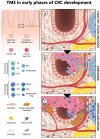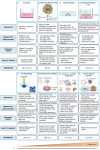Advancements in 3D In Vitro Models for Colorectal Cancer
- PMID: 38962943
- PMCID: PMC11348154
- DOI: 10.1002/advs.202405084
Advancements in 3D In Vitro Models for Colorectal Cancer
Abstract
The process of drug discovery and pre-clinical testing is currently inefficient, expensive, and time-consuming. Most importantly, the success rate is unsatisfactory, as only a small percentage of tested drugs are made available to oncological patients. This is largely due to the lack of reliable models that accurately predict drug efficacy and safety. Even animal models often fail to replicate human-specific pathologies and human body's complexity. These factors, along with ethical concerns regarding animal use, urge the development of suitable human-relevant, translational in vitro models.
Keywords: colorectal cancer; patient‐derived organoids; preclinical models for cancer; tumor microenvironment.
© 2024 The Author(s). Advanced Science published by Wiley‐VCH GmbH.
Conflict of interest statement
The authors declare no conflict of interest.
Figures







Similar articles
-
Preclinical models as patients' avatars for precision medicine in colorectal cancer: past and future challenges.J Exp Clin Cancer Res. 2021 Jun 5;40(1):185. doi: 10.1186/s13046-021-01981-z. J Exp Clin Cancer Res. 2021. PMID: 34090508 Free PMC article. Review.
-
Could 3D models of cancer enhance drug screening?Biomaterials. 2020 Feb;232:119744. doi: 10.1016/j.biomaterials.2019.119744. Epub 2019 Dec 26. Biomaterials. 2020. PMID: 31918229 Review.
-
Development of primary human pancreatic cancer organoids, matched stromal and immune cells and 3D tumor microenvironment models.BMC Cancer. 2018 Mar 27;18(1):335. doi: 10.1186/s12885-018-4238-4. BMC Cancer. 2018. PMID: 29587663 Free PMC article.
-
Deciphering the Tumor Microenvironment of Colorectal Cancer and Guiding Clinical Treatment With Patient-Derived Organoid Technology: Progress and Challenges.Technol Cancer Res Treat. 2024 Jan-Dec;23:15330338231221856. doi: 10.1177/15330338231221856. Technol Cancer Res Treat. 2024. PMID: 38225190 Free PMC article. Review.
-
Patient-Derived In Vitro Models for Drug Discovery in Colorectal Carcinoma.Cancers (Basel). 2020 May 31;12(6):1423. doi: 10.3390/cancers12061423. Cancers (Basel). 2020. PMID: 32486365 Free PMC article. Review.
Cited by
-
Host-microbe-cancer interactions on-a-chip.Front Bioeng Biotechnol. 2025 Mar 31;13:1505963. doi: 10.3389/fbioe.2025.1505963. eCollection 2025. Front Bioeng Biotechnol. 2025. PMID: 40230461 Free PMC article. Review.
-
In vitro 3D modeling of colorectal cancer: the pivotal role of the extracellular matrix, stroma and immune modulation.Front Genet. 2025 May 1;16:1545017. doi: 10.3389/fgene.2025.1545017. eCollection 2025. Front Genet. 2025. PMID: 40376304 Free PMC article. Review.
-
Development of Liver Cancer Organoids: Reproducing Tumor Microenvironment and Advancing Research for Liver Cancer Treatment.Technol Cancer Res Treat. 2024 Jan-Dec;23:15330338241285097. doi: 10.1177/15330338241285097. Technol Cancer Res Treat. 2024. PMID: 39363866 Free PMC article. Review.
References
Publication types
MeSH terms
Grants and funding
LinkOut - more resources
Full Text Sources
Medical
